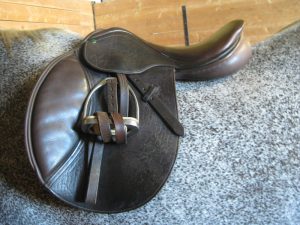Thrush. That black, gooey, foul smelling gunk that appears around a horse’s frog and heels. Thrush is a bacterial infection caused by a bacteria that occurs naturally in our horse’s environment but grows best in low oxygen, moist places. This means that horses are most likely to develop thrush when their feet stay wet and dirty, such as in a muddy field or a dirty stall. Horses that have deep clefts alongside their frogs, or narrow, contracted heels are also more likely to develop thrush.
Thrush is very common, and a horse can develop a mild case quickly, and can recover quickly as well if the environment dries out and or the infection is treated. However, if thrush is left untreated and nothing is changed about the environment causing the thrush, it can worsen to a point where the horse will be lame. The infection will keep working deeper until more sensitive areas of the foot are affected, causing the lameness.
The first and best treatment for thrush is to put the horse in a drier location, so his foot can essentially air out. There are many products on the market for treating thrush, but I have found that without some sort of environment change, it will persist or at least come back. You may need to clean your horse’s stall more often, or put stone down where the worst of the mud is in his field. Sometimes it is virtually impossible to do much for his environment, so you may need to just be diligent about picking his feet and applying treatment. If your horse does have deep clefts or contracted heels talk to your farrier about possibly trimming him in a way that allows the hoof to function better. Your farrier can also use a hoof knife to cut away excess frog tissue which may be trapping dirt and mud.
The best product I have found for treating thrush is the purple liquid called Thrush Buster. There are generic versions of this that I have found to work just as well, such as Durvet Thrush Rid. On mild cases, I have also used a more (emphasis on more, not entirely) natural product called Arti-Mud. Arti-mud is basically a putty that you press into the clefts of the frog or the crack of the heel to treat the trush and help keep the mud and dirt out. It contains clay, honey, zinc oxide, and eucalyptus oil and has a nice smell. Unfortunately, you won’t find this one in many tack stores. I order it online.
I have used numerous other products such coppertox, bleach, and the cow mastitis treatment tubes called “today” and “tomorrow,” but I still consider the purple stuff number one for clearing up the thrush in fewer treatments and not being as messy as some of the other products, however it does stain, so be careful not to get any on your hands or clothing.
Which thrush treatment do you use? Do you have other remedies I didn’t mention here?
Here is a link for the Thrush Rid:
and this is where you can order Arti-Mud: https://redhorseproducts.com/shop-2/hoof-care/artimud/












